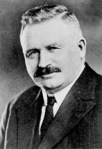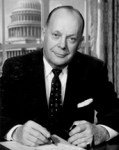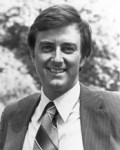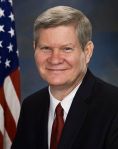This is the third of several posts previewing the Tuesday election through a historical lens. The first part was an introduction and the second part looked at South Dakota’s history of supporting Republican presidential tickets.
 Senator John Thune is heavily favored to win reelection this Tuesday. Every public poll has given Thune a strong double-digit lead over his Democratic opponent, Jay Williams. FiveThirtyEight gives Thune a 99.8% chance of being reelected, estimating that he will win 64.4% of the vote.
Senator John Thune is heavily favored to win reelection this Tuesday. Every public poll has given Thune a strong double-digit lead over his Democratic opponent, Jay Williams. FiveThirtyEight gives Thune a 99.8% chance of being reelected, estimating that he will win 64.4% of the vote.
Thune is seeking more than just reelection in 2016. He is poised to join an elite group of notable figures in South Dakota history, becoming only the seventh South Dakotan to be elected three times to the U.S. Senate. Here are the other six:
1. Peter Norbeck (R-Redfield) – Norbeck was a businessman, state legislator, and lieutenant governor before being elected Governor in 1916. During his four years as governor, he founded Custer State Park, held the first pheasant hunting season, and started the state cement plant and other state-owned enterprises. Norbeck was elected to the Senate in 1920, and reelected in 1926 and 1932. His 1932 reelection came amidst the FDR Democratic landslide, and he was the only Republican elected statewide in South Dakota that year. In the Senate, Norbeck was an early advocate for the construction of Mount Rushmore and supported creation of Badlands National Monument and Grand Tetons National Park. He died in 1936, just over two years before the end of his third term.
Norbeck’s life is recounted in an excellent biography by Gilbert Courtland Fite, available from South Dakota Historical Society Press.
2. Karl E. Mundt (R-Madison) – Mundt was a teacher and a professor at General Beadle State College (today Dakota State University). He was elected to the U.S. House in 1938, serving for ten years before winning Senate seat in 1948. As a Senator, he was a firm anti-communist, becoming a close friend and ally of Richard Nixon. Mundt is the only U.S. Senator from South Dakota to serve four terms – he won his third over a challenge from Congressman George McGovern. In late 1969, he suffered a debilitating stroke that robbed him of his ability to speak. Mundt declined entreaties to resign, and served in his seat until it ended in 1973. He lost his committee assignments, and his wife, Mary, and longtime staffers operated his Senate office in his absence.
Mundt’s life is chronicled in a detailed and well-researched biography, A Fair Chance for a Free People by Scott Heidepriem.
3. George McGovern (D-Mitchell) – Like Mundt, McGovern was a college professor, working at Dakota Wesleyan. As executive secretary of the Democratic Party in the 1950s, he brought the party back from its all-time low point, winning a U.S. House seat for himself in 1956 over incumbent Harold Lovre. After unsuccessfully challenging Senator Mundt in 1960, he served as director of President Kennedy’s “Food for Peace” program, then won the other U.S. Senate seat in 1962. McGovern was the Democratic nominee for President in 1972, losing badly to President Nixon in a 49-state sweep. He won a third term in 1974, but his status as a liberal icon made him vulnerable, and he was defeated amidst the 1980 Reagan Revolution by Congressman Jim Abdnor.
Several books have been written about McGovern, including most recently The Rise of a Prairie Statesman by Thomas J. Knock. Also recommended are Hunter S. Thompson’s Fear and Loathing on the Campaign Trail ’72 (an example of Thompson’s unique “gonzo journalism”), and Joshua M. Glasser’s excellent book The Eighteen-Day Running Mate, which chronicles the disastrous selection and withdrawal of Senator Eagleton. (Pivotal scenes in the book take place at Custer State Park’s Sylvan Lake Lodge.)
4. Larry Pressler (R-Humboldt) – Pressler was first elected to Congress in 1974, defeating Democratic incumbent Frank Denholm. Pressler was an incredibly popular electoral figure, winning reelection in 1976 with 79.8% of the vote. In 1978, Pressler easily won a U.S. Senate seat, and was reelected in 1984 and 1990. In 1996, Congressman Tim Johnson, himself an electoral powerhouse over five House terms, challenged Pressler. It was a hard-fought campaign, but Pressler fell short, making him the only incumbent Republican senator to lose reelection that year.
Pressler made two failed attempts to return to electoral politics. In 2002, Pressler was in a five-person field for the Republican nomination for U.S. House, finishing a distant second to outgoing Governor Bill Janklow. In 2014, Pressler ran for the U.S. Senate as an independent, winning 17.1% and a respectable third-place finish as former Governor Mike Rounds won the open seat.
No biographies have been written about Pressler; however, Pressler himself wrote an excellent book of biographical sketches of South Dakota’s U.S. Senators, U.S. Senators from the Prairie, which I used as a reference for this blog post.
5. Tom Daschle (D-Aberdeen) – Daschle successfully ran for U.S. House in 1978, seeking the seat Pressler vacated to run for U.S. Senate. In 1982, after South Dakota lost its second House seat, he defeated fellow incumbent Congressman Clint Roberts, a Republican Lyman County rancher. In 1986, Daschle ran for the U.S. Senate, defeating Senator Abdnor, who had suffered a tough primary challenge from Gov. Bill Janklow. In 1994, Daschle became the Senate Minority Leader. He led the Democrats in the Senate for ten years, including two as Majority Leader. In 2004, Daschle nearly ran for President, but instead sought a fourth Senate term. Daschle’s position as a national Democratic leader made it difficult for him to maintain the support of the conservative South Dakota electorate, and after an expensive campaign, he lost to former Congressman John Thune 50.6% to 49.4%.
6. Tim Johnson (D-Vermillion) – The most recent three-term U.S. Senator from South Dakota is Tim Johnson. After four terms in the legislature, Johnson was elected to the U.S. House in 1986, winning the seat being vacated by Tom Daschle, who was elected to the U.S. Senate. After ten years in the U.S. House, he successfully challenged Senator Pressler in 1996. Johnson was narrowly reelected in 2002, defeating Congressman Thune by only 527 votes. Ironically, Johnson’s election victory sowed the seeds for Thune’s defeat of Senator Daschle two years later. In late 2006, Johnson suffered a brain hemorrhage that caused stroke-like symptoms, including difficulty with movement and speech. Unlike Senator Mundt, however, Johnson was able to stage a recovery, and he won an easy reelection victory in 2008.
Johnson retired in 2014, declining to seek a fourth term and ending his career without an election loss. Although he was often overshadowed by Daschle during his congressional career, Johnson is the most successful Democrat in South Dakota electoral history – 8-0 in statewide campaigns, winning an average of 61% of the vote. In those eight elections, Johnson won a total of 1,553,967 votes – second all-time in South Dakota behind only Bernard Linn, who was elected Commissioner of School and Public Lands 11 times from 1948 to 1968.






